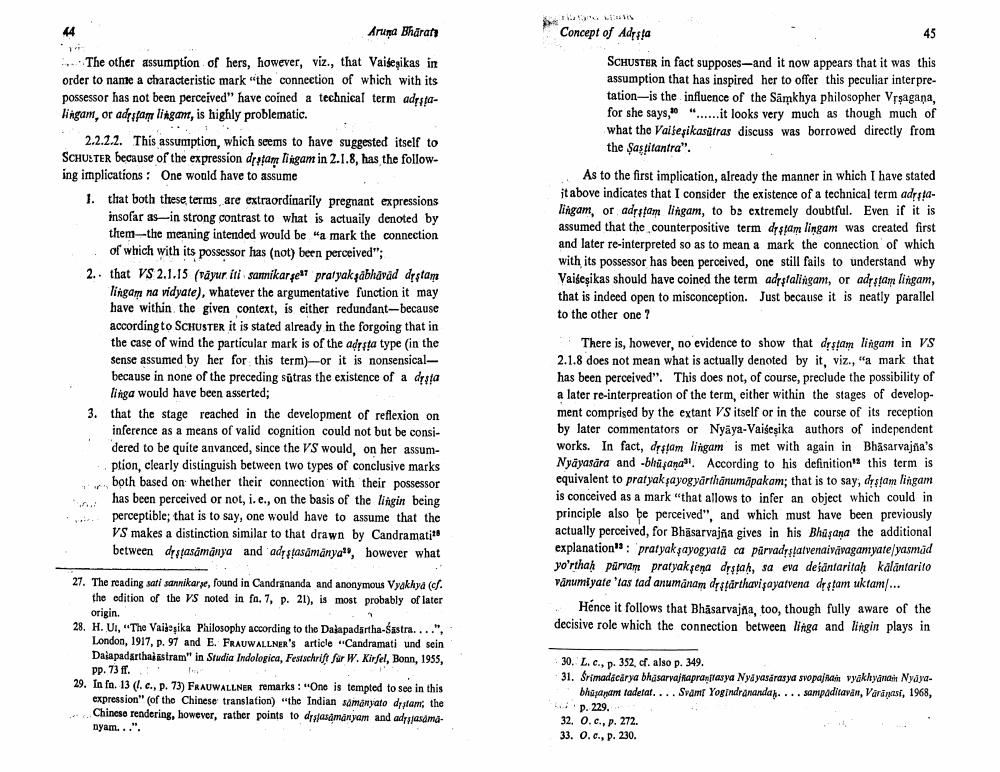Book Title: Note On Concept Adrsta As Used In Vaisesika Sutra Author(s): A Wezler Publisher: A Wezler View full book textPage 6
________________ Aruma Bharat Concept of Adrsla ... The other assumption of hers, however, viz., that Vaidepikas in order to name a characteristic mark the connection of which with its possessor has not been perceived" have coined a technical term adppaLingam, or adesamlingant, is highly problematic. 2.2.2.2. This assumption, which seems to have suggested itself to SCHUSTER because of the expression dragon Tingam in 2.1.8, has the following implications: One would have to assume 1. that both these terms are extraordinarily pregnant expressions insofar as-in strong contrast to what is actuaily denoted by them--the meaning intended would be a mark the connection of which with its possessor has (not) been perceived"; 2.. that VS 2.1.15 (vayur iti samikar selt pratyak zábhavad destan Tingam na vidyate), whatever the argumentative function it may have within the given context, is either redundant--because according to SCHUSTER it is stated already in the forgoing that in the case of wind the particular mark is of the adrsta type (in the sense assumed by her for this term)-or it is nonsensicalbecause in none of the preceding sutras the existence of a dosta linga would have been asserted; 3. that the stage reached in the development of reflexion on inference as a means of valid cognition could not but be considered to be quite anvanced, since the VS would, on her assumption, clearly distinguish between two types of conclusive marks both based on whether their connection with their possessor has been perceived or not, i. c., on the basis of the lingin being perceptible; that is to say, one would have to assume that the VS makes a distinction similar to that drawn by Candramatis between drapasamanya and adesfasamanya", however what SCHUSTER in fact supposes--and it now appears that it was this assumption that has inspired her to offer this peculiar interpretation-is the influence of the Samkhya philosopher Vrsagana, for she says, " "...... it looks very much as though much of what the Vallepikasätras discuss was borrowed directly from the Şastitantra". As to the first implication, already the manner in which I have stated it above indicates that I consider the existence of a technical term adrsalingam, or adestam lingam, to be extremely doubtful. Even if it is assumed that the counterpositive term despam lingam was created first and later re-interpreted so as to mean a mark the connection of which with its possessor has been perceived, one still fails to understand why Vaiscşikas should have coined the term adržalingam, or adestam lingam, that is indeed open to misconception. Just because it is neatly parallel to the other one ? There is, however, no evidence to show that desam lingam in VS 2.1.8 does not mean what is actually denoted by it, viz., "a mark that has been perceived". This does not, of course, preclude the possibility of a later re-interpreation of the term, either within the stages of development comprised by the extant VS itself or in the course of its reception by later commentators or Nyāya-Vaiseșika authors of independent works. In fact, dream lingam is met with again in Bhäsarvajna's Nyayasära and -bhūsanal According to his definition this term is equivalent to pratyakayogyárthanumāpakam; that is to say, dysamlingam is conceived as a mark that allows to infer an object which could in principle also be perceived", and which must have been previously actually perceived, for Bhäsarvajna gives in his Bhasana the additional explanation": "pratyakayogyată ca parvadestalvenaivivagantyate/yasmad yo'rthah parvam pratyak gena drstah, sa eva delantarilah kåläntarito vänumlyate 'tas tad anumanam disfarthavigayatvend desfamuktam/... Hence it follows that Bhasarvajna, too, though fully aware of the decisive role which the connection between linga and lingin plays in 27. The reading sati sannikarze, found in Candrananda and anonymous Vyakhya (cf. the edition of the VS noted in fo. 7, p. 21), is most probably of later origin. 28. H.UI. "'The Vaijepika Philosophy according to the Dalapadartha-Sastra....". London, 1917, p. 97 and E. FRAUWALLNER'S article "Candramati und sein Dalapadarthalsstram" in Studia Indologica, Festschrift fur W. Kirfel, Bonn, 1955, pp. 73 fr. 29. In fa. 13 (l. c., p. 73) FRAUWALLNER remarks: One is tempted to see in this expression of the Chinese translation) "the Indian samanyato delam, the Chineso rendering, however, rather points to dejasamanyam and addnyam...". 30. L. c., p. 352. c. also p. 349. 31. Srimaddeirya bhusarvajapalasya Nyd yasdrasya sopa Wakhyan Nyayo bhi t tadetar.... Svam Yogindrananda....ampaditard, Vanes, 1968, p. 229. 32. 0.c., p. 272. 33. 0. c., p. 230.Page Navigation
1 ... 4 5 6 7 8 9 10 11 12 13
